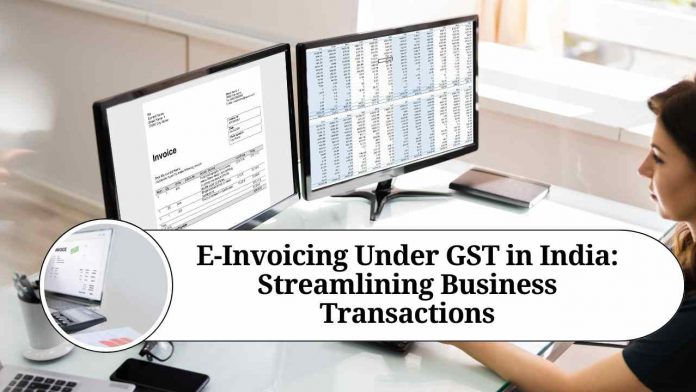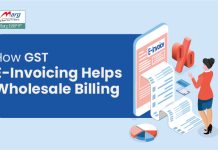Introduction
In recent years, technology has revolutionized various aspects of our lives, and the way businesses operate is no exception. One significant development in the realm of business transactions is the implementation of e-invoicing under the Goods and Services Tax (GST) regime in India. E-invoicing has emerged as a transformative tool that streamlines the invoicing process, enhances compliance, and reduces errors. This blog explores the concept of e-invoicing under GST in India and its benefits for businesses.
Understanding E-Invoicing:
E-invoicing, or electronic invoicing, refers to the process of generating, transmitting, and managing invoices in an electronic format. Under the GST framework, e-invoicing entails the generation of a standardized invoice in a machine-readable format, which is then validated by the Invoice Registration Portal (IRP) before being transmitted to the recipient. The objective is to ensure consistency, accuracy, and interoperability in the invoicing process across the country.
Key Features and Requirements:
Invoice Registration Portal (IRP):
The IRP serves as the central hub for the e-invoicing system. It validates the invoices in real-time, assigns a unique Invoice Reference Number (IRN), and generates a digitally-signed QR code for each invoice.
Standard Format (Schema):
E-invoices are generated in a standardized format known as the e-invoice schema. The schema ensures uniformity and facilitates seamless data exchange between different accounting systems.
Invoice Generation:
Businesses are required to generate e-invoices in the prescribed format for supplies made to registered persons (B2B) with an aggregate turnover exceeding a specified threshold. Initially, e-invoicing was applicable to businesses with a turnover exceeding INR 500 crores, but the threshold has been gradually lowered to include more businesses.
IRN and QR Code:
The IRP validates each e-invoice and assigns a unique IRN, which is then digitally signed and embedded in a QR code. The QR code contains essential details of the invoice, enabling quick verification by the recipient or tax authorities.
Benefits of E-Invoicing:
Reduction in Errors:
E-invoicing eliminates manual data entry errors, as the invoice details are directly populated into the system from the source. This reduces the chances of discrepancies and enhances accuracy in invoicing.
Enhanced Compliance:
The real-time validation and authentication of invoices by the IRP ensure compliance with GST regulations. This leads to improved transparency and minimizes the risk of fraudulent activities.
Faster Payment Cycles:
With e-invoicing, invoices are processed swiftly, enabling faster payment cycles. The standardized format and quick transmission result in reduced processing times and improved cash flow for businesses.
Seamless Integration:
E-invoicing systems can be integrated with accounting software, Enterprise Resource Planning (ERP) systems, and other business tools. This integration streamlines the invoicing process, eliminates duplication of efforts, and enhances operational efficiency.
Conclusion
E-invoicing under GST in India marks a significant step toward modernizing business transactions. By embracing technology, businesses can streamline their invoicing process, reduce errors, enhance compliance, and improve overall efficiency. As the government continues to expand the applicability of e-invoicing to smaller businesses, it is crucial for organizations to embrace this digital transformation and leverage its numerous benefits. Adopting e-invoicing not only ensures compliance with GST regulations but also contributes to a more seamless and transparent business ecosystem in India.
Read more useful content:
Frequently Asked Questions (FAQs)
Q1: What is e-invoicing under GST?
A1: E-invoicing under GST refers to the process of generating, transmitting, and managing invoices in an electronic format. It involves the creation of standardized invoices in a machine-readable format, which are validated by the Invoice Registration Portal (IRP) and then transmitted to the recipient.
Q2: Who needs to generate e-invoices under GST?
A2: Initially, e-invoicing was applicable to businesses with an aggregate turnover exceeding INR 500 crores. However, the threshold has been gradually lowered, and currently, it applies to businesses with a turnover exceeding a specified threshold (as determined by the government). It is advisable to check the latest threshold limits announced by the authorities.
Q3: What are the key features of e-invoicing?
A3: The key features of e-invoicing under GST in India include the use of the Invoice Registration Portal (IRP) for validation, the adoption of a standardized format (e-invoice schema), the assignment of a unique Invoice Reference Number (IRN), and the generation of a digitally-signed QR code for each invoice.
Q4: How does e-invoicing reduce errors?
A4: E-invoicing minimizes manual data entry errors as the invoice details are directly populated into the system from the source. This reduces the chances of discrepancies and enhances accuracy in invoicing.
Q5: Does e-invoicing improve compliance with GST regulations?
A5: Yes, e-invoicing ensures enhanced compliance with GST regulations. The real-time validation and authentication of invoices by the IRP contribute to improved transparency and minimize the risk of fraudulent activities.
Q6: Does e-invoicing facilitate faster payment cycles?
A6: Yes, e-invoicing enables faster payment cycles. With standardized formats and quick transmission, invoices are processed swiftly, reducing processing times and improving cash flow for businesses.
Q7: Can e-invoicing be integrated with existing accounting systems?
A7: Yes, e-invoicing systems can be seamlessly integrated with accounting software, Enterprise Resource Planning (ERP) systems, and other business tools. This integration streamlines the invoicing process, eliminates duplication of efforts, and enhances operational efficiency.
Q8: What information does the QR code on e-invoices contain?
A8: The QR code on e-invoices contains essential details such as the Invoice Reference Number (IRN), invoice number, date of issue, supplier’s GSTIN, recipient’s GSTIN, HSN code, invoice value, and other relevant information. The QR code enables quick verification by the recipient or tax authorities.
Q9: Are there any penalties for non-compliance with e-invoicing under GST?
A9: Non-compliance with e-invoicing provisions under GST may attract penalties as per the applicable regulations. It is essential for businesses to stay updated with the requirements and ensure timely compliance to avoid penalties.
Q10: Where can businesses find more information about e-invoicing under GST?
A10: Businesses can refer to the official GST portal (https://www.gst.gov.in) for detailed information on e-invoicing, including notifications, user manuals, FAQs, and other resources. They can also consult qualified professionals or experts in the field to understand specific requirements and implementation processes.




















